

"The papers spoke very well of my works, in fact better than I would have thought they would, as I was a foreigner. However, harsh observations were made insofar as the exposed nudity was concerned: . . . I was in fact the first to have risked exhibiting nude figures in America, in Boston in particular. I had removed the veil of chastity and purity from Puritanism."
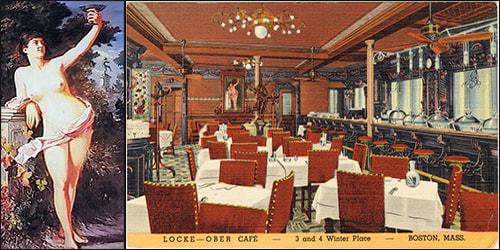
Whatever disappointments he may have felt over the Michigan Capitol commission, Juglaris continued to blaze new trails in Boston. He took particular pride in making the human nude a conspicuous presence in a city famous for its prudery.
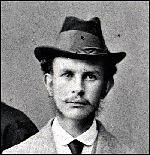
In 1848 Boston had been one of the stops on the national tour of Hiram Powers' famous female nude statue, The Greek Slave. But sculpted in white marble, which disarmed its sensuality, Powers’s statue of an enslaved Christian woman dangling a cross was also veiled in moral narrative: her nudity was an emblem of her victimhood at the hands of her rapacious, infidel Ottoman captors. More tacitly she served as a reminder of the recent Greek quest for independence from Ottoman Turkish rule. Consequently, The Greek Slave could be exhibited with moral impunity on the Boston Commons to large crowds eager to pay the admission price to view the tented beauty.
The phenomenal success of Powers’s Greek Slave emboldened a local Boston artist, Edward Augustus Brackett, to sculpt in life-sized marble the poignant scene of a shipwrecked mother and infant, clothing stripped away, washed ashore dead. Both the use of white marble and the lack of consciousness of the depicted subjects averted any prurient intent. After public exhibition, Brackett’s Shipwrecked Mother and Child found a home in the Statuary Hall of the Athenaeum, a private library for the city’s most elite gentlemen.
Over the ensuing years, caution remained the watchword in civic artistic matters, particularly with regard to nudes. Three decades later and only four years prior to Juglaris’s arrival on American shores, the Boston Museum of Fine Arts still felt obliged to add fig leaves to the plaster casts of the classical statuary gracing its galleries.
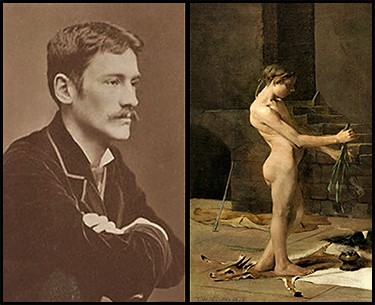
In the late 1870s at least one budding American artist, Thomas Wilmer Dewing, did successfully exhibit two small academic nudes in the relative privacy of the Boston Art Club. According to the arts writer from the Boston Evening Transcript for January 22, 1878, they attracted “the admiration of artists for their marvelous subtlety and perfection of drawing and flesh painting.” Yet the first of these Dewing works, A Sorcerer’s Slave, offered a profile, rather than a full frontal view, of a naked prepubescent boy. As in the case of Hiram Powers’s Greek Slave, the captive status of Dewing’s young subject lent an added innocence. Meanwhile, Dewing’s second nude, A Musician, exuded its own aura of modesty. As described by art historian Susan A. Hobbs, it depicted a living but “gently slumbering” woman in a vaguely classical-style pose holding a violin and bow over her richly draped lap with only her torso exposed and one breast bared. At little more than a foot tall and not even a foot wide, neither Dewing nude was large. All of these mitigating factors no doubt combined to avert any public outrage over their Art Club showing.
Although he would not have known it at the time, Juglaris arrived in Boston at a cultural tipping point for the public display of nudes. Indeed, in October 1880, within weeks of Thomas Dewing’s permanent move to a more cosmopolitan and open-minded New York City, Juglaris found himself as a new Boston resident caught up in a swirl of controversy over his own comfortable depiction of nudity in much larger works of art.
The tempest arose in conjunction with a “Living American Artists” exhibition at the Museum of Fine Arts on Copley Square. Despite his Italian nationality, Juglaris was invited to present two of his Paris Salon paintings, Venetian Promenade and The Invasion. As last-minute additions and perhaps with decorous intent, the paintings were hung high over a gallery doorway. Yet this did not obscure the nudity of the male and female figures at the center of The Invasion. While no more brazen or provocative than what, only a generation later, might be typically viewed in National Geographic photographs of “primitive” peoples, Juglaris’s rendering of a prehistoric couple sans chemise prompted pointed criticism of the art authorities in charge. For his own part, Juglaris rather reveled in the scandal generated. As he recounts in his memoirs: "The papers spoke very well of my works, in fact, far better than I would have thought they would, as I was a foreigner. However, harsh observations were made insofar as the exposed nudity was concerned... I was in fact the first to have risked exhibiting nude figures in America, in Boston in particular. I had removed the veil of chastity and purity from Puritanism. They forgave me because I was a foreigner, but hard things were said to the [organizing] committee and the [museum's] administrators."
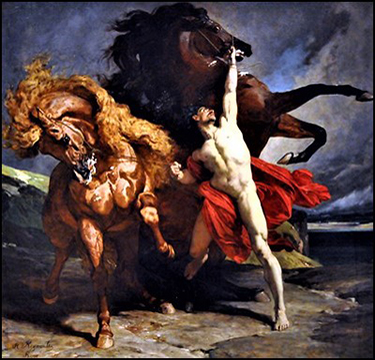
Boston’s Puritan mores continued to linger—and mostly prevail. In 1880-81 artist and famous poet’s son Ernest Wadsworth Longfellow, whom Juglaris had first met in France as part of Thomas Couture’s circle, sought authorization from the Museum of Fine Arts trustees to lead a class in drawing from the nude at its attached school. Permission was granted but only reluctantly so, and on a conditional basis: strictly male models could be employed. Furthermore, all nude sessions had to be conducted behind locked doors to avoid publicity and attendant notoriety. Thereafter, in 1882 when Juglaris successfully entered a public competition for a teaching post with the Boston Art Club and what he termed the “Boston Academy of Art,” he encountered the same exasperating prudishness. Not surprisingly, given Boston sensitivities, the live model provided for the competition was male. Yet, as Juglaris recalls in his memoirs, only the model’s upper torso was made visible. All else had to be imagined by Juglaris and his fellow artist-contestants from experience elsewhere. Even among artists any greater anatomical exposure was still deemed unseemly and inappropriate in a more public setting.
However, no doubt aided by Juglaris’s own earlier breach and infringement upon prevailing cultural norms, more definite change was in the air. In 1883, the William and Everett Gallery, where Juglaris periodically exhibited his own work, presented for public view a provocative narrative painting by French artist George Henri Regnault, Automedon and the Horses of Achilles. It portrays the well-muscled frontal nude figure of Automedon grasping with outstretched arm the bridle of one of Achilles’s horses. Thereafter, the painting’s owner, Samuel Coale of St. Louis, Missouri, loaned it to the Boston Museum of Fine Arts for ongoing display.In 1885, the same year that a “nude debate” was raging across the Atlantic in London and Boston moralists were further roiled by male nude photography displayed at a Boston Art Club exhibition organized by the local Society of Amateur Photographers (Boston Camera Club), museum students lobbied for the outright purchase of Regnault’s painting. Thereafter began a fruitful five-year campaign to make this possible by popular subscription.
Meantime, discerning opportunity and seizing it, Juglaris made the nude a more public reality—indeed a fixture—in Boston by completing (1885-86) a full-length portrait of a very statuesque and exuberantly posed women. It was duly installed in the so-called “Men’s bar” at Locke-Ober’s, a popular restaurant on Winter Place a half-block from the Boston Commons and just two streets over from his own Bromfield Street studio. Part of a wave of “saloon nudes” by such major European artists as Jules Lefebvre and Adolph Bouguereau, Juglaris’s Mlle. Yvonne—as the painting was entitled—became in succeeding years something of a cherished Boston legend even as the original shock of her more brazen nudity faded.
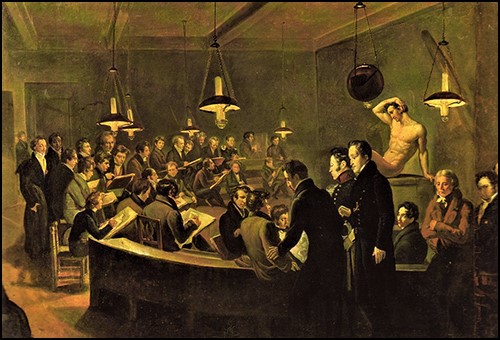
For the next 125 years Mlle. Yvonne remained on display. Exciting attention and comment for decades, the Juglaris painting emerged as a tourist attraction in it own right. In the 1940s Holiday magazine published a large photo of bowler-hatted businessmen nonchalantly lunching in front of Mlle. Yvonne. Soon after the Boston Sunday Herald archly described Juglaris as an artist “with a flair for figure painting that is stunningly apparent.“ As a restaurant popular with Harvard University students and alumni, including future U.S. President John F. Kennedy, Locke-Ober’s made it a custom to drape Mlle. Yvonne in black whenever Harvard lost to Yale in their annual football match. During the 1980s, Locke-Ober patrons organized the Mlle. Yvonne Club. Members loyally sported fancy red dress suspenders emblazoned with double images of Juglaris’s voluptuous lady.
In his own role as art teacher, Juglaris continued to do his best to encourage and foster the study of the nude which he regarded as foundational for learning how to skillfully draw any human figure, dressed or undressed. As early as 1881-82, when the Boston Art Cub was contemplating a new clubhouse on Newberry Street in Back Bay, Juglaris was consulted on the appropriate design of an amphitheater for life drawing classes, based on his own experiences with art schools and "theaters of the nude" in Europe, beginning at Turin's Accademia Albertina. During his years as resident instructor at the Boston Art Club, Juglaris had occasion to make use of the amphitheater for classes, employing semi-nude or nude models. Not surprisingly, when fellow Boston artists gathered to honor Juglaris's contribution to the city's art life, each table was decorated with a nude figure as a centerpiece.